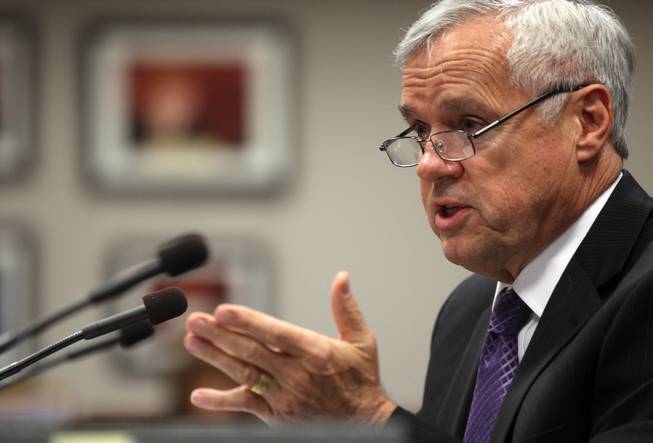
AP Photo/Cathleen Allison
Dan Klaich, chancellor of the Nevada System of Higher Education, testifies Monday, June 6, 2011, at the Legislature in Carson City as lawmakers wrap up their 120-day Legislative session.
Friday, Aug. 24, 2012 | 5:02 p.m.
Sun coverage
UNLV will receive nearly $2 million more and UNR will receive $1.3 million less next fiscal year if the governor and legislature sign off on a proposed new higher education funding formula.
Nevada legislators and higher education leaders have been working for the past nine months on a new funding model that proponents say will be more simple, fair and transparent.
The new formula allows Nevada’s seven colleges and universities to keep their own tuition and fees, allocates general fund money based on a school’s mission and course offerings, and rewards institutions that graduate more students.
Although there have been many discussions among legislators, educators and consultants, the proposed figures that would be allotted to each institution under the new funding model have not been revealed … until now.
On Friday, the Nevada System of Higher Education’s board of regents approved its fiscal 2014 budget proposal, which will be submitted to Gov. Brian Sandoval in September. The vote was nearly unanimous; Regent Ron Knecht was the sole dissenting vote.
If approved, the budget would redistribute $362 million in general fund money based on the proposed funding formula. Some institutions also may receive “mitigation” money to ease into the funding changes for the first year.
Rural colleges, which received the brunt of the funding formula cuts, would be given additional funding, as well, to alleviate changes under the new model.
According to the proposed budget, here is what each institution would receive: (These figures are contingent upon approval from the governor’s office and the passage of the new funding formula during the upcoming legislative session in February.)
• UNLV would receive $125.9 million, which is an increase of nearly $2 million from last year. Per-pupil funding would be $6,614, up from $6,447.
• UNR would receive $91 million, a decrease of about $1.3 million from last year. Per-pupil funding would be $6,491, down from $6,581.
• College of Southern Nevada would receive nearly $82 million, an increase of about $4.4 million from last year. Per-pupil funding would be $4,183, up from $3,835.
• Nevada State College would receive about $11 million, an increase of about $1.9 million from last year. Per-pupil funding would be $6,184, up from $4,642.
• Great Basin College in Elko would receive $13.3 million, a decrease of about $760,000. Per-pupil funding would be $5,184, down from $7,684.
• Truckee Meadows Community College in Reno would receive $30.1 million, a decrease of about $480,000. Per-pupil funding would be $4,427, down from $4,887.
• Western Nevada College in Carson City would receive $14.3 million, a decrease of about $756,000. Per-pupil funding would be $4,404, down from $6,312.
During his presentation to the regents, Chancellor Dan Klaich said his proposed budget and funding formula was not perfect but was a step in the right direction. The debate over higher education funding has gotten heated — especially between legislators and Klaich — but the outcome is a new formula framework that “addresses a decades-old problem of equity in the system,” he said.
“This hasn’t been a friend-making project,” Klaich said.
Regents said the formula would need tweaking as it’s being put into effect. They also said other fundamental issues — such as the overall lack of funding for higher education and whether local governments should run community colleges — also would need to be worked out.
However, most of the regents seemed pleased with the direction of the new funding formula in solving what one regent called a “north-south problem” in the current formula.
“This is long overdue,” said Regent Jack Schofield, who has served on the board for the past decade. “This is a move in a real positive direction so we can bring peace to the state.”
UNLV President Neal Smatresk agreed the new formula was a step in the right direction but said it wouldn’t be in full effect for a couple of years. The university — which has seen multimillion-dollar cuts since the recession began — will still need more funding, Smatresk added.
“It’s a significant improvement over the previous formula. It is fundamentally more fair,” Smatresk said. “No one is getting as much as we want. We’re in a state that has cut higher education massively.”
CSN President Michael Richards echoed Smatresk’s comments. Although CSN is the largest higher education institution in the state, it historically has been given the least in per-pupil funding of all seven institutions, he said.
Under the new formula, CSN will receive $4.4 million in additional state funding — the most of any Nevada college or university — but its per-pupil funding still will be among the lowest, Richards said. Even with the increase, CSN will be getting less in per-pupil funding than all the Northern Nevada community colleges.
“This new formula is a long-term solution to CSN’s long-term funding inequity,” Richards said. “But we’re still way below other institutions.”

Join the Discussion:
Check this out for a full explanation of our conversion to the LiveFyre commenting system and instructions on how to sign up for an account.
Full comments policy